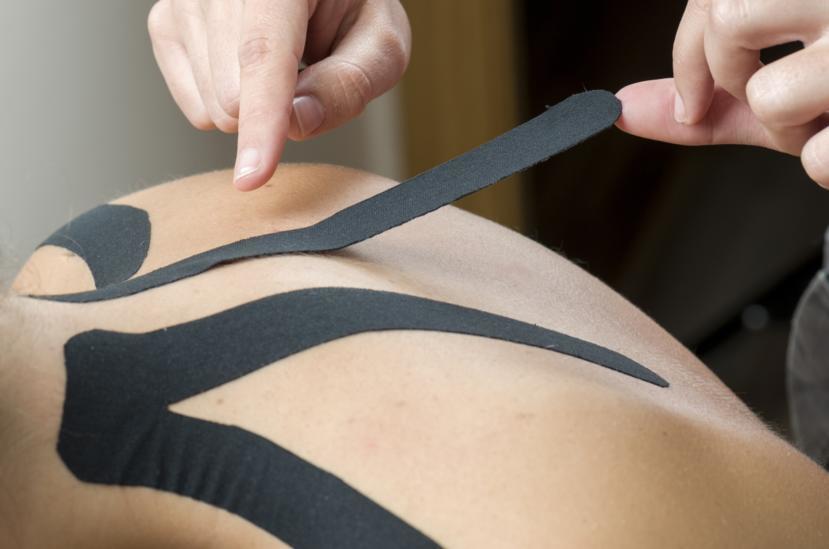What Is Kinesiology Tape Used For?

What is a kinesiology tape?
Kinesiology tape is a thin, elastic adhesive tape made from cotton or cotton/nylon blend. The cotton strip is comfortable and hypoallergenic without topics ingredients or medications. Several different brands of tapes are available. The common brand names of kinesiology tapes are KT Tape and Kinesio Tape. The injured area of the body can be stabilized by these tapes. It also helps the body to completely heal without reducing the range of motion. Kinesiology tape is commonly used in knees, calves, elbows, shins, wrist, and shoulders.
Kinesiology tapes are also clinically used to reduce pain, improve posture, relieve swelling, along with an enhanced function and performance in sports and other activities. The tape is waterproof and wearable for 3-5 days when properly applied. The tape is available in a variety of different colors and designs.
The benefits of the tape depend on its use and application. The key to a successful taping is the proper placement and amount of stretch put through it. You can go to a physical therapist or healthcare professionals who specialize in taping to help you learn. Taping is part of a natural rehabilitation program, but if you have serious injuries, you may need other therapies to completely recover.
The original tape was designed by the Japanese chiropractor and acupuncturist named Dr. Kenzo Kaze in 1979. According to Dr. Kase, the regular athletic tape was very restrictive, which would obstruct the flow of fluid beneath the skin. He said that applying a flexible tape to injured muscles could enhance proper circulation and lymphatic drainage. The vacuum effect of the tape could provide a cooling effect as well as minimizing swelling and further damage.
However, some people are still skeptical about its benefits and consider the tape only as a placebo. After using the tape, others feel that it has some sort of medication that can stimulate the healing process. The tape can support, enable, or restrict the movement of soft tissues. The load can be distributed and moved away from the damaged muscles and tendons. Tissue function can also be augmented with the help of the tape, thereby preventing further injury.
Who can benefit from kinesiology taping?
- Individuals with a job that requires repetitive motion. They include mechanics, miners, construction workers, and landscapers.
- People working hunched for hours over the desk or people living a sedentary lifestyle, which can cause neck and back pain.
- People involved in a lot of physical activities such as athletes, which include cyclists, runners, tennis players, or golfers.
- People suffering from back pain and headaches due to uncomfortable or poor sleep.
- People with osteoarthritis, arthritis, and other health conditions.
- Individuals with recent muscle, tendon, or joint injury.
Kinesiology tape has extensive use and benefits, which is why it is known as a magic tape. In athletic and healthcare settings, its unique features have made kinesiology tape one of the most widely used therapeutic modality. The following are features of kinesiology tape:
- It is effective when used alone, but for greater impact, it can be combined with other therapeutic modalities.
- It has few contraindications and without any side effects.
- Some people can apply it all by themselves.
- It is one of the most effective therapeutic modalities available.
- It is least expensive.
- It is wearable for several days with therapeutic effects.
Other Features:
- Joint Corrections - The range of motion in the joints can be increased and the muscles can be loosened by correctly using the kinesiology tape.
- Endogenous Analgesic System - No medications or drugs are used in this therapeutic modality. It is endogenous, which means that it allows the body to heal by itself.
Benefits of Kinesiology Taping
1. Pain Relief
Acute and chronic pain can be effectively relieved by kinesiology tape without the use of medications or topical substances. It is capable of slightly lifting the skin due to its elasticity. The pressure is immediately reduced on the sensitive pain receptors under the skin. A competitive stimulus is provided by the stimulating effect on pain pathways. Thus, the pain signals going to the brain are blocked. It is especially effective in cases of "hot" injuries, wherein the pain is extreme and out of proportion.
It was explained by Dr. Kase that pain receptors are present between the epidermis and dermis. It would be possible to lift the epidermis slightly up by applying the tape to the painful area. Thus, space is created between the first and the second skin layer. Kinesiology tape is thin, soft, and stretchy similar to the human skin. When compared to other tapes, its thin elasticized fabric allows the skin to easily breathe.
More movement is also possible when kinesiology tape is used since it is less firm and stiff. Using body heat, the material easily bonds with the skin since it is made of unique materials. Moreover, the tape gently tugs to the skin without causing any pain. Thus, blood flow is stimulated in the affected area during physical therapy, throughout the day, and rehabilitation sessions, which promote faster healing.
2. Reduces Swelling and Inflammation
The removal of fluids can be enhanced by reducing the pressure on the channels of lymphatic drainage. Other materials that collect in that area are also removed. Kinesiology taping is beneficial not only in the case of sports injuries, but also in other inflammatory conditions such as lymphedema and post-surgical recovery.
Kinesiology taping provides a passive lift through the tape's elasticity. This vacuum effect allows lymphatic and venous drainage leading to a reduction in swelling.
3. Speedy Recovery from Contusions and Bruises
Due to bruising, blood is accumulated under the skin. This blood can be removed by kinesiology taping. The tape is applied over the bruised area in a fan pattern and dissipation of the bruising happens through the skin lifting mechanism.
4. Prevents and Relieves Muscle Cramps and Spasms
The delivery of oxygen and nutrients is improved due to an enhanced circulation. Thus, nutrients and oxygen are delivered to overused or fatigued muscles, which helps relieve or prevent muscle spasms and cramps.
5. Speedy Recovery of Overused Muscles
By-products of exercise are present in overused or fatigued muscles. When kinesiology tape is applied over the affected areas, the removal of these byproducts is enhanced, thereby enabling a speedy and rapid recovery. Through enhanced blood flow, the delivery of oxygen is also improved. Hence, there would be an improved performance in an endurance event, and a complete recovery between high-intensity, repetitive events.
6. Supports Injured Muscles and Joints (without restricting the range of motion)
Kinesiology taping provides support to the injured joints and muscles without limiting the range of motion because of the tape's unique elastic properties.
7. Athletes Can Remain Active Even While Injured
For competitive athletes, remaining active is one of the most important benefits of kinesiology taping. Overstretching or overcontraction of injured muscles can be prevented by applying kinesiology tapes. It also enables the athletes to continue their training while their injury heals. This is attributed to the anti-inflammatory and pain-relieving properties of the kinesiology tape.
8. Enhances Strength and Muscle Tone
Muscles can become weak due to certain neurological or muscular disorders. Support to these muscles is provided by kinesiology taping. Muscle activation is also improved through the application of kinesiology tape. For young children with hypotonia, this benefit is of major use. Kinesiology taping can also be an advantage for children with a limited ability to sit up or crawl due to poor muscle tone. It also assists in mobility and improves one's posture.
9. Reduces Low Back Pain
In 2016, a study published in the Journal of Bodywork and Movement Therapies showed the effectiveness of kinesiology taping when it comes to relieving low back pain. According to the study, when kinesiology taping is combined with other therapeutic modalities such as physical therapy, a decrease in lower back pain can be achieved. Its findings showed that the range of motion, motor control, and muscular endurance could be improved by kinesiology taping.
Not every study has been able to find this effect on the patients, particularly when kinesiology tape was used alone. However, some studies have proven that kinesiology taping can reduce pain along the spine and lower back when it is combined with exercise and stretching.
10. May Treat Running Injuries
Kinesiology taping may be helpful for those dealing with running injuries. These running injuries include:
- Plantar fasciitis
- Shin splints
- Knee pain
- Runner’s knee
- Hamstring pulls
- Aches and other types of pain due to overuse or poor form
It has been proven by some studies that kinesiology taping can also help ankle balance and stabilization. There has been evidence that those with knee osteoarthritis have made their physical activities easier through kinesiology taping. In one study on quadriceps torque, the effects of both kinesiology tape and placebo tape were determined through standardized stair-climbing tasks and knee pain in patients with osteoarthritis. There were significant improvements in the peak quadriceps torque, stair-climbing tasks, and knee pain through kinesiology taping. The study concluded that kinesiology taping was helpful in reducing knee pain in osteoarthritis. It was also found that kinesiology taping was helpful in improving the range of motion.
11. Recovery from Wrist or Shoulder Injuries
Mixed results have been found in patients using kinesiology tape to treat shoulder injuries. Some studies have shown that kinesiology taping may help decrease the pain and disability in younger patients with shoulder impingement or tendonitis. However, for patients with shoulder impingement, the use of kinesiology tape should be used as an adjuvant treatment and not as a stand-alone solution.
How does it work?
The traditional tape would constrain the muscles and tightly hold them together, which would prevent further injury and movement. However, kinesiology taping works opposite to this. It allows full movement by opening up the muscles.
The kinesiology tape is applied on and around the injury or strain, but do not encircle the muscle or tendon since this will constrain the movement. The skin and connective tissues are moved away from the injured area. Thus, the lymphatic fluid can freely flow, which enables healing of the inflamed tissues. It naturally helps the body heal on its own.
Skepticism
Even though kinesiology taping is very popular among athletes, its benefits have been disputed by many healthcare professionals and scientists. There is still no strong evidence to prove that kinesiology tapes can reduce pain. There have been inconsistent results about the kinesiology tape's potential to increase the range of motion. The only thing known is that kinesiology taping has a larger effect on muscle activity, but whether this change is beneficial in any way is still unclear.














